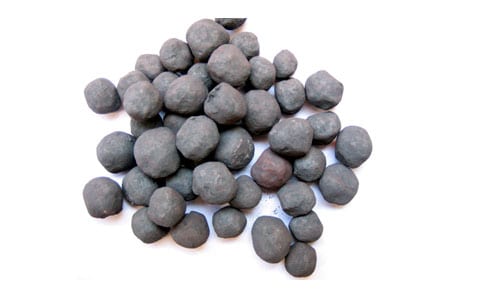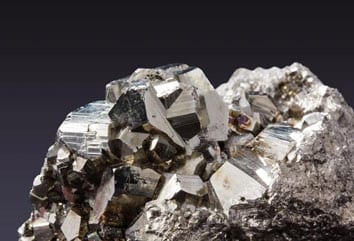ਭਾਸ਼ਾ ਚੁਣੋ:
Iron ore is the fourth most common element in the earth’s crust. Iron is essential to steel manufacturing and, ਇਸ ਲਈ, an essential material for global economic development. ਆਇਰਨ ਵੀ ਵਿਆਪਕ ਹੈ ਅਤੇ ਉਸਾਰੀ ਦੇ ਕੰਮ ਵਿਚ ਵਰਤਿਆ ਗਿਆ ਹੈ ਵਾਹਨ ਦੇ ਨਿਰਮਾਣ. Most iron ore resources are composed of metamorphosed banded iron formations (BIF), ਜਿਸ ਵਿੱਚ ਲੋਹੇ ਆਮ ਆਕਸਾਈਡ ਦੇ ਰੂਪ ਵਿੱਚ ਪਾਇਆ ਗਿਆ ਹੈ, hydroxides, ਅਤੇ, to a lesser extent, carbonates.
The chemical composition of iron ores is apparent to be wide, especially for Fe content and associated gangue minerals. Major iron minerals associated with most iron ores are hematite, goethite, limonite, and magnetite. ਲੋਹੇ ores ਵਿੱਚ ਮੁੱਖ ਗੰਦਗੀ SiO2 ਅਤੇ Al2O3 ਹਨ. The typical silica and alumina-bearing minerals present in iron ores are quartz, kaolinite, gibbsite, ਡਾਇਸਪੋਰ, and corundum. ਇਹ ਦੇ, it is often observed that quartz is the main silica-bearing mineral, and kaolinite and gibbsite are the two main alumina-bearing minerals.


Iron ore extraction is mainly performed through open pit mining operations, ਮਹੱਤਵਪੂਰਨ tailings ਪੀੜ੍ਹੀ ਦੇ ਨਤੀਜੇ. ਲੋਹੇ ਦਾ ਉਤਪਾਦਨ ਸਿਸਟਮ ਨੂੰ ਆਮ ਤੌਰ 'ਤਿੰਨ ਪੜਾਅ ਸ਼ਾਮਲ ਹੈ: ਮਾਈਨਿੰਗ, ਨੂੰ ਕਾਰਵਾਈ ਕਰਨ, and pelletizing activities. Processing ensures that an adequate iron grade and chemistry are achieved prior to the pelletizing stage. ਪ੍ਰੋਸੈਸਿੰਗ ਪਿੜਾਈ ਵੀ ਸ਼ਾਮਲ ਹੈ, ਵਰਗੀਕਰਨ, ਮਿਲਿੰਗ, and concentration, with the aim of increasing the iron content while reducing the amount of gangue minerals. Each mineral deposit has its own unique characteristics with respect to iron and gangue-bearing minerals, and therefore, it requires a different concentration technique.
Magnetic separation is typically used in high-grade iron ore beneficiation, where the dominant iron minerals are ferro and paramagnetic. ਵੈੱਟ ਅਤੇ ਖੁਸ਼ਕ ਘੱਟ ਤੀਬਰਤਾ ਚੁੰਬਕੀ ਵੱਖ (LIMS) techniques are used to process ores with strong magnetic properties, such as magnetite, while wet high-intensity magnetic separation is used to separate the Fe-bearing minerals with weak magnetic properties, such as hematite, from gangue minerals. Iron ores such as goethite and limonite are commonly found in tailings and do not separate very well by either technique.

ਤੈਰਾਕੀ ਦੇ ਘੱਟ-ਗਰੇਡ ਲੋਹੇ ores ਵਿਚ ਛਵੀ ਦੀ ਸਮੱਗਰੀ ਨੂੰ ਘੱਟ ਕਰਨ ਲਈ ਵਰਤਿਆ ਗਿਆ ਹੈ,. ਆਇਰਨ ores ਕਿਸੇ ਲੋਹੇ ਆਕਸਾਈਡ ਦੀ ਸਿੱਧੀ anionic ਤੈਰਾਕੀ ਦੇ ਕੇ ਜ ਿਸਿਲਕਾ ਦੇ cationic ਤੈਰਾਕੀ ਉਲਟਾ ਧਿਆਨ ਕੀਤਾ ਜਾ ਸਕਦਾ ਹੈ; ਪਰ, reverse cationic flotation remains the most popular flotation route used in the iron industry. The use of flotation is limited by the cost of reagents, the presence of silica and alumina-rich slimes, and the presence of carbonate minerals. ਇਸ ਦੇ ਨਾਲ, flotation requires wastewater treatment and the use of downstream dewatering for dry final applications.
The use of flotation for the concentration of iron also involves desliming, as floating in the presence of fines results in decreased efficiency and high reagent costs. Desliming ਕਾਫ਼ੀ ਮੁਸ਼ਕਲ ਹੁੰਦਾ ਹੈ ਕਿਸੇ ਵੀ ਸਤਹ-ਸਰਗਰਮ ਏਜੰਟ ਦੇ ਕੇ ਹੈਮੇਟਾਈਟ ਜ goethite ਤੱਕ gibbsite ਦੇ ਵੱਖ ਤੌਰ 'ਤੇ alumina ਨੂੰ ਹਟਾਉਣ ਲਈ ਖਾਸ ਤੌਰ' ਤੇ ਜ਼ਰੂਰੀ ਹੈ. Most alumina-bearing minerals occur in the finer size range (<20a), desliming ਦੁਆਰਾ ਇਸ ਨੂੰ ਹਟਾਉਣ ਲਈ ਸਹਾਇਕ ਹੈ. ਓਵਰਆਲ, ਜੁਰਮਾਨੇ ਦੀ ਇੱਕ ਉੱਚ ਇਕਾਗਰਤਾ (<20a) ਅਤੇ ਐਲੂਮਿਨਾ ਲੋੜੀਂਦੀ ਕੈਸ਼ਨਿਕ ਕੁਲੈਕਟਰ ਖੁਰਾਕ ਨੂੰ ਵਧਾਉਂਦੀ ਹੈ ਅਤੇ ਚੋਣਵੇਂਤਾ ਨੂੰ ਨਾਟਕੀ ਢੰਗ ਨਾਲ ਘਟਾਉਂਦੀ ਹੈ. ਇਸ ਲਈ, desliming increases flotation efficiency but results in a large volume of tailings and in loss of iron to the tailings stream.
Dry processing of iron ore presents an opportunity to eliminate costs and wet tailings generation associated with flotation and wet magnetic separation circuits. STET has evaluated several iron ore tailings and run-of-mine ore samples at bench scale (pre-feasibility scale). Significant movement of iron and silicates was observed, with examples highlighted in the table below.

ਇਸ ਅਧਿਐਨ ਦੇ ਨਤੀਜੇ ਦਿਖਾਇਆ ਕਿ ਘੱਟ-ਗਰੇਡ ਲੋਹੇ ਜੁਰਮਾਨੇ STET tribo-ਇਲੈਕਟ੍ਰੋਸਟੈਟਿਕ ਬੈਲਟ ਵੱਖਰੇ ਦੇ ਜ਼ਰੀਏ ਅੱਪਗਰੇਡ ਕੀਤਾ ਜਾ ਸਕਦਾ ਹੈ. Based on STET experience, ਉਤਪਾਦ ਵਸੂਲੀ ਅਤੇ / ਜ ਗ੍ਰੇਡ ਕਾਫ਼ੀ ਪਾਇਲਟ ਸਕੇਲ ਨੂੰ ਕਾਰਵਾਈ ਕਰਨ 'ਤੇ ਸੁਧਾਰ ਹੋਵੇਗਾ, ਅਦਾਲਤ-ਪੈਮਾਨੇ ਦਾ ਟੈਸਟ ਜੰਤਰ ਨੂੰ ਇਹ ਲੋਹੇ ਟਰਾਇਲ ਦੇ ਦੌਰਾਨ ਵਰਤਿਆ ਦੇ ਮੁਕਾਬਲੇ.
The STET dry electrostatic fine iron ore separation process offers many advantages over traditional wet processing methods, such as magnetics or flotation, ਸਮੇਤ:
Contact us to learn more about dry processing of iron ore.
ਹਵਾਲੇ:
Iron ore beneficiation involves a series of processes that aim to improve the purity and quality of raw iron ore. These processes include crushing, ਪੀਸਣਾ, ਚੁੰਬਕੀ ਵੱਖ, ਤੈਰਾਕੀ, and gravity separation, depending on the mineralogical characteristics of the ore. Each technique is selected based on the ore’s composition and feasibility to extract the maximum amount of iron while minimizing impurities.
Iron ore mining requires specialized equipment to handle the extraction and processing of ore. Common machinery includes ball mills for grinding, crushers for reducing the size of ore, magnetic separators for separating iron particles from impurities, flotation machines for fine particle separation, and conveyors for transport.
Technologies utilized for iron ore beneficiation include advanced techniques such as dry electrostatic separation, ਤੈਰਾਕੀ, advanced gravity separation, and sensor-based sorting. These technologies aim to efficiently increase the iron content and eliminate contaminants, catering to the growing demand for high-grade iron ore and promoting sustainable mining practices.
The cost of iron ore beneficiation can vary significantly depending on the specific processes and technologies used, the grade of the raw ore, and the desired purity of the final product. It encompasses capital expenditure (Capex), such as equipment and plant construction, and operational expenditure (Opex), including labor, ਊਰਜਾ, ਅਤੇ consumables. It’s essential for companies to evaluate these costs against prospective revenue and market demands to ensure project viability.